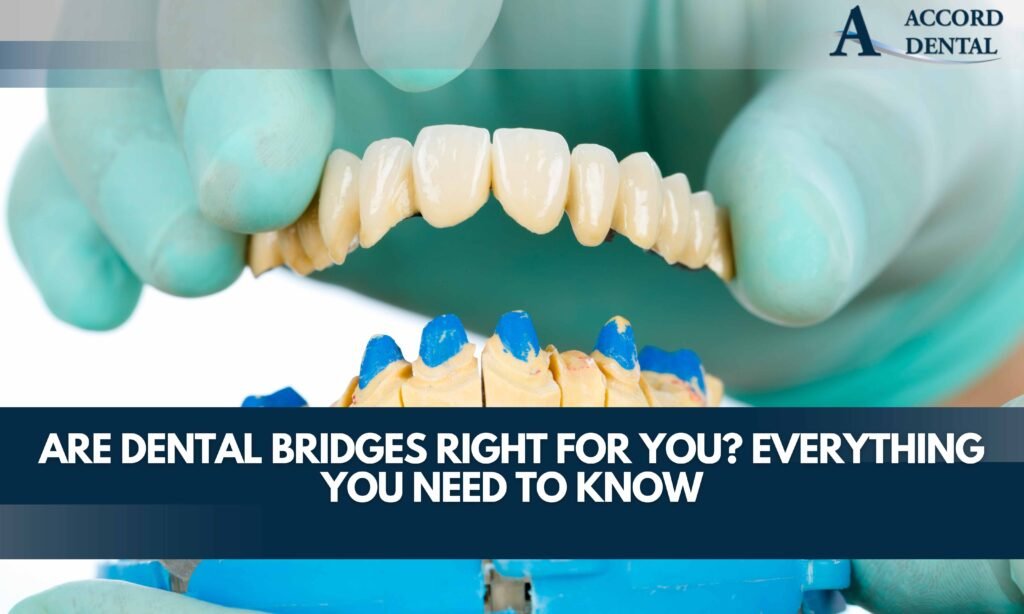A bright, healthy smile plays a pivotal role in boosting self-confidence and promoting good oral health. However, when you lose a tooth or several teeth, it can significantly impact not just your appearance but your ability to eat, speak, and maintain a healthy bite. Fortunately, dental bridges offer an effective solution for filling these gaps. If you’re missing teeth and wondering whether dental bridges are the right choice for you, We will walk you through everything you need to know about dental bridges, their benefits, types, procedures, and how they can improve your overall quality of life.
What Are Dental Bridges?
Dental bridges are dental devices designed to replace one or more missing teeth by bridging the gap between your remaining natural teeth. They are composed of artificial teeth (pontics) supported by dental crowns that are cemented onto the adjacent teeth, providing a fixed and permanent solution for missing teeth. In some cases, dental implants are used instead of adjacent natural teeth to support the bridge, offering additional stability and support. Dental bridges are custom-designed to match the shape, color, and size of your natural teeth, ensuring a seamless and natural look. The use of dental bridges is one of the most effective and reliable ways to restore both the functionality and appearance of your smile.
Types of Dental Bridges
Not all dental bridges are the same. There are different types designed to cater to specific needs, preferences, and circumstances. Let’s take a look at the most common types of dental bridges:
Traditional Dental Bridges
Traditional dental bridges are the most common type used for replacing one or more missing teeth. They consist of a false tooth (pontic) that fills the gap and is supported by crowns placed on the healthy teeth adjacent to the missing tooth. The supporting teeth must be filed down to accommodate the crowns, which makes this type of bridge a great choice for patients who have strong, healthy adjacent teeth.
Cantilever Dental Bridges
Cantilever bridges are used when there is only one adjacent tooth to support the bridge. This type of bridge is anchored on just one side and is generally recommended in areas that do not undergo significant pressure during chewing. Cantilever bridges are most commonly used for replacing front teeth.
Maryland Dental Bridges
Also known as resin-bonded bridges, Maryland bridges use a metal or porcelain framework that is bonded to the back of the adjacent teeth. Unlike traditional bridges, the adjacent teeth do not need to be crowned. Maryland bridges are less invasive and are typically used for replacing missing front teeth, where aesthetics and minimal tooth reduction are key considerations.
Implant-Supported Bridges
An implant-supported bridge is an excellent option for people who don’t want to rely on natural teeth for support. In this case, dental implants are surgically placed into the jawbone to support the bridge. This type of bridge is ideal for individuals who have lost multiple teeth and need a durable, long-lasting solution. Implant-supported bridges are more stable and offer improved comfort when compared to traditional bridges, as they don’t require the adjacent teeth to be altered.
Benefits of Dental Bridges
Dental bridges are an excellent solution for many individuals with missing teeth. Let’s explore some of the key benefits that dental bridges offer:
Restores Functionality
One of the primary reasons people opt for dental bridges is to restore the functionality of their teeth. Missing teeth can make chewing food difficult and even painful. With dental bridges, you’re able to chew, bite, and eat more comfortably and naturally. They also help improve your speech, as missing teeth can often lead to slurred speech or difficulty pronouncing certain words.
Enhances Aesthetic Appearance
Missing teeth can significantly affect your smile and self-confidence. Dental bridges fill the gaps, restoring the natural appearance of your teeth. With custom-made bridges that match the color, size, and shape of your existing teeth, they blend seamlessly into your smile.
Prevents Teeth from Shifting
When a tooth is lost, the surrounding teeth may begin to shift toward the empty space. This can cause misalignment, bite problems, and even damage to the remaining teeth. Dental bridges help to prevent this by filling the gap and keeping the remaining teeth in their proper position.
Preserves Jawbone Health
When a tooth is lost, the jawbone in the area may begin to deteriorate over time. This occurs because the bone no longer receives stimulation from the missing tooth’s root. Dental bridges help preserve the jawbone by providing support to the surrounding teeth, thus preventing bone loss in the affected area.
Durable and Long-Lasting
Dental bridges are designed to be durable and long-lasting, with the right care. On average, they can last anywhere from 5 to 15 years, depending on the type of bridge and your oral hygiene habits. In some cases, with good maintenance, dental bridges can even last longer.
The Procedure for Getting Dental Bridges
The process of getting a dental bridge is relatively straightforward and typically requires two or more dental appointments. Here’s a step-by-step breakdown of what you can expect during the procedure:
Initial Consultation and Assessment
Your journey to getting a dental bridge begins with an initial consultation with your dentist. During this appointment, your dentist will examine your oral health, the condition of the surrounding teeth, and your overall dental history to determine if dental bridges are the right solution for you. If you have any underlying oral health issues such as gum disease or tooth decay, these will need to be treated first.
Preparing the Adjacent Teeth
If you’re opting for a traditional or cantilever dental bridge, your dentist will prepare the adjacent teeth by reshaping them to ensure they can properly hold the bridge. In some cases, a dental crown will be placed over these teeth to provide the necessary support for the bridge.
Taking Impressions
Once your teeth are prepared, your dentist will take detailed impressions of your mouth. These impressions are used to create a custom dental bridge that fits perfectly in your mouth. This step ensures that the bridge will align with your existing teeth and feel comfortable in your mouth.
Temporary Bridge Placement
While the permanent dental bridge is being crafted in a dental laboratory, you’ll be fitted with a temporary bridge to protect the exposed teeth and gums. The temporary bridge will allow you to continue eating and speaking normally while you wait for the permanent bridge to be ready.
Fitting and Cementing the Permanent Bridge
When the permanent dental bridge is ready, you’ll return to your dentist’s office for a final fitting. Your dentist will check the fit, color, and alignment of the bridge to ensure it matches your natural teeth. If everything looks good, the bridge will be permanently cemented into place.
Aftercare and Maintenance
Once your dental bridge is placed, you’ll need to take good care of it to ensure its longevity. This includes practicing proper oral hygiene, avoiding hard or sticky foods, and scheduling regular dental check-ups. Your dentist may also recommend using floss threaders or special cleaning tools to clean around the bridge and prevent plaque buildup.
How Long Do Dental Bridges Last?
Dental bridges are a durable and long-lasting solution to missing teeth. On average, dental bridges can last between 5 to 15 years, depending on the type of bridge, the material used, and how well you take care of your oral health. With proper care and regular dental check-ups, you can extend the life of your dental bridge for many years.
Are Dental Bridges Right for You?
While dental bridges are an effective and reliable solution for many people, they may not be suitable for everyone. It’s important to consider several factors before deciding whether dental bridges are the right choice for you.
The Condition of Your Adjacent Teeth
For traditional dental bridges, the adjacent teeth must be healthy and strong enough to support the bridge. If the supporting teeth are damaged or decayed, you may need additional treatments such as crowns or implants to ensure the bridge is properly supported.
Bone Density
If you’re considering an implant-supported bridge, your jawbone must have sufficient density to support the implants. If your jawbone has weakened due to tooth loss, a bone graft may be necessary before implants can be placed.
Oral Hygiene
Maintaining good oral hygiene is crucial for the success of dental bridges. If you have gum disease or cavities near the gap, these issues need to be treated before a bridge can be placed. Ensuring that you follow your dentist’s aftercare instructions is essential to keeping your bridge in excellent condition.
Personal Preferences
Dental bridges are a great solution for many people, but if you prefer a more permanent solution with a more natural feel, dental implants may be a better option. Discuss your preferences with your dentist to determine the best choice for your needs.
What to Expect During Recovery
After getting a dental bridge, you might experience some discomfort or mild sensitivity as your mouth adjusts to the new device. This is a normal part of the healing process and typically resolves within a few days. It’s important to follow your dentist’s aftercare instructions, which may include using a special mouth rinse, avoiding certain foods, and practicing excellent oral hygiene. During your recovery, avoid chewing on hard foods, sticky substances, or anything that could potentially damage the bridge. Over time, as your mouth adjusts to the bridge, you should feel completely comfortable and able to eat and speak as normal.
How to Maintain Dental Bridges
The key to ensuring your dental bridge lasts for many years is maintaining excellent oral hygiene. Here are a few tips for keeping your dental bridge in top condition:
- Brush and Floss Daily: Brush your teeth at least twice a day with a soft-bristled toothbrush and fluoride toothpaste. Floss around your bridge using a floss threader or special bridge floss to remove food particles and plaque.
- Avoid Hard Foods: Although dental bridges are durable, it’s still a good idea to avoid chewing hard foods like ice, hard candy, or nuts, which can potentially damage the bridge.
- Regular Dental Check-ups: Visit your dentist regularly for check-ups and professional cleanings. This ensures that your dental bridge is properly maintained and that any issues are detected early.
- Use a Night Guard: If you grind your teeth at night, consider using a night guard to protect your bridge from excessive pressure.
Conclusion
Dental bridges are an excellent solution for restoring your smile, functionality, and confidence after losing a tooth or multiple teeth. With a variety of options available, dental bridges can be customized to fit your specific needs and preferences. Whether you choose a traditional bridge, a cantilever bridge, or an implant-supported bridge, they can provide long-lasting and effective results. If you’re looking for Dental Bridges in Grafton, MA, a consultation with your local dentist can help you determine whether this is the right solution for you. They will examine your oral health, discuss your treatment options, and guide you through the process. For those considering Dental Bridges in Grafton, understanding the procedure, benefits, and care involved is essential to making an informed decision. Consulting with a dentist who specializes in dental restorations will help ensure that your treatment plan is personalized and successful. To ensure you receive the best care possible, it’s crucial to work with a trusted Dentist in Grafton, MA who can guide you through the process, ensuring your new dental bridge fits well, feels comfortable, and enhances your smile for years to come.






